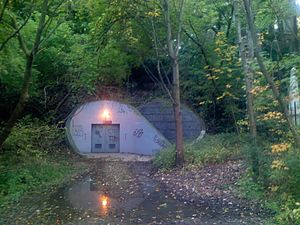1995 Russell Hill subway accident

The Russell Hill Emergency exit located in Winston Churchill Park near Castle Frank Brook
|
|
| Date | August 11, 1995 |
|---|---|
| Time | 6:02 p.m. |
| Location | Toronto, Ontario |
| Country | Canada |
| Rail line | Yonge-University-Spadina |
| Operator | Toronto Transit Commission |
| Type of incident | collision |
| Cause | operator error, equipment malfunction |
| Statistics | |
| Trains | H5, H1 |
| Deaths | 3 |
| Injuries | 30 hospitalized, 100+ filled claims |
The 1995 Russell Hill subway accident was a deadly train crash that occurred in Toronto, Ontario, Canada on Yonge-University-Spadina line of the Toronto subway on August 11, 1995. Three people were killed and 30 were taken to hospital with injuries when one train rear-ended another train. The subway line was shut down for five days following the incident. Investigations found that human error and a design flaw in the mechanical safety devices caused this accident. It remains the deadliest accident in a rapid transit system in Canadian history.
At 6:02 p.m. on August 11, 1995, a subway train running southbound on the Yonge-University-Spadina line ran into the rear of a stationary train halfway between St. Clair West and Dupont stations. There were between 200 and 300 passengers on the two trains, of whom three were killed and 30 taken to hospital with injuries; about 100 more later filed injury claims against the TTC. Many of the seriously injured were extracted from the twisted remains of the most damaged subway cars by rescue workers who worked through the evening under extremely hot and humid conditions. Of the four crew members, three were taken to hospital with injuries.
The accident had two direct causes: first the inexperienced driver, Robert Jeffrey, who mistook the signals, and the train stop which failed to protect the train due to a design error.
The TTC subway uses conventional wayside signals without cab signalling. Thus drivers are expected to remember each signal aspect and act accordingly until they receive new information from the following signal. The following description is limited to aspects relevant to the accident.
Some signals are "automatic" and have a single head that shows one of the three basic colours. Red means stop and stay (until presented with a less restrictive signal aspect), yellow means that the next signal is red and the driver should prepare to stop, and green means that the next signal is not red and it is safe to proceed at normal speed.
...
Wikipedia
